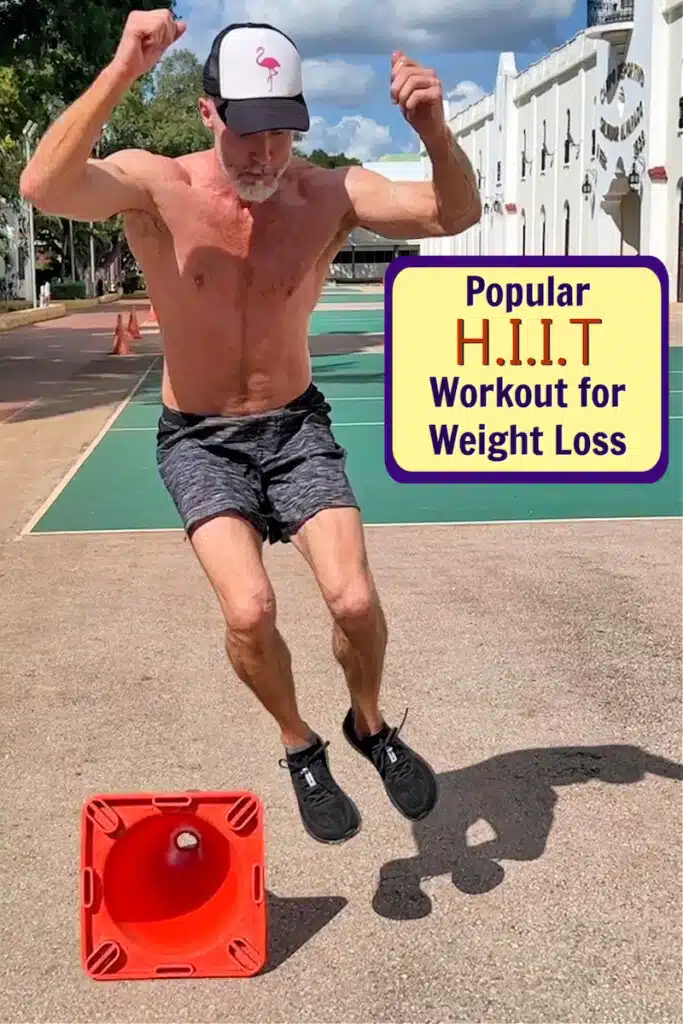You can be lean, or you can be strong. But you know what’s even better? To be both lean and strong at the same time. In my decades as a professional fitness trainer, I’ve discovered that – even though it’s more difficult to be trim and muscled simultaneously – high-intensity interval training (HIIT) makes it possible. In this HIIT workout for weight loss, I show you why running intervals to burn fat is a winning idea – and just how much fun it can be.
The video below will prove helpful.
HIIT vs. Cardio: Why Intervals Crush Weight Loss Goals
Did you know that – when compared to standard steady-state cardio – intervals inspire lower appetite, greater excess post-exercise oxygen consumption (EPOC), improved blood lipid profiles and blood pressure readings, increased VO2 max output, and favorable endocrine modulation? (See additional sources at end of article.)
Additionally, HIIT is considered beneficial for you because the intervals help with increased calorie burn:
- You can burn calories both during and after exercise due to its high-intensity nature, which can help with weight loss or weight management.
- HIIT is shown to increase the body’s metabolic rate, which can help burn more calories throughout the day.
One study indicated that HIIT elevates metabolism even hours after exercise, leading to increased calorie burning and improved metabolic processes.
Additionally, research comparing resistance training and HIIT demonstrated significantly higher energy expenditure post-exercise for both modalities, highlighting the effectiveness of HIIT for long-term weight control and metabolic benefits.
Furthermore, a study published in eLife revealed that HIIT boosts proteins essential for energy metabolism and muscle contraction in skeletal muscle, explaining its beneficial effects on metabolism.
Extra Benefits of a Jumping and Running Intervals Workout
Intervals are remarkably effective, yet fat-burning isn’t the only benefit of HIIT. It’s also more enjoyable.
What’s fascinating is that jumping and running during intervals is similar to what children (and those of us who are young at heart) do while playing.
Don’t be surprised if, after this workout, your body is humming with endorphins, and your mood is noticeably brighter. Compared to other types of exercise, intervals are just more fun.

Here are additional benefits to higher-intensity interval training:
Improved insulin sensitivity – The common belief used to be that weight loss was all about calories. Today, there is an evolving understanding that weight loss is influenced not just by calorie intake but also by the body’s insulin response. Therefore, interventions that address insulin tend to be helpful.
HIIT has been shown to improve insulin sensitivity, which can help with blood sugar control and may reduce the risk of developing type 2 diabetes.
A meta-analysis indicated that HIIT is an effective exercise intervention for enhancing postprandial glycemic markers and improving insulin sensitivity.
Additionally, another study demonstrated that HIIT reduces insulin resistance in obese individuals.
Furthermore, research has shown that HIIT enhances liver and adipose tissue insulin sensitivity independently of body weight and adiposity, emphasizing its positive impact on metabolic health.
Improved cardiovascular fitness – Intervals have been shown to improve cardiovascular fitness by increasing the heart’s ability to pump blood and oxygen to the working muscles more efficiently. Great for your lungs, too.
“The take-home message for aging adults is that supervised high-intensity training is probably best, because – both metabolically and at the molecular level – it confers the most benefits.”
–Dr. S.K. Nair, Mayo Clinic
Time efficiency – HIIT workouts are typically shorter than steady-state cardio workouts or bodybuilding sessions, making them an attractive option for people with less time to exercise.
Better muscle – There’s a reason that sprinters look lean, strong, and powerful – yet marathoners look simply skinny. Intervals develop muscle!
Vigorous Intervals for Effective Weight Loss & Improved Fitness
Sometimes I call this workout “Sprint Day,” but, really, it’s a series of speed and agility drills that strengthen and condition the entire body while – and I love this part – burning an astounding amount of calories.
Intervals are challenging, but they can be a lot of fun.
Circuit training combines several exercises – intervals – performed with short rest periods between them.
One circuit is when all of the chosen exercises have been completed.
Multiple circuits can be performed in one training session.
How many times you go through each circuit is determined by your current fitness level:
- Beginners = 2x each circuit
- Intermediates = 3x each circuit
- Advanced Athletes = 4x each circuit.
How many repetitions (“reps”) you do is up to you, but 12 is a good number to shoot for. If you’re a beginner, do fewer. If you’re advanced, do more.
The intensity level for a circuit training session is typically higher than a standard gym workout.
I like to do my circuit training outdoors when possible. However, with simple modifications, intervals can be done inside, too.
INTERVALS WITHIN CIRCUIT A
– Jog Backward
– Jog Forward
– Grapevine (each direction)
– Side Shuffle (each direction)
– Jump Rope
INTERVALS WITHIN CIRCUIT B
– Exaggerated Skip
– Butt Kick
– Knee Up
– Jog Backward
INTERVALS WITHIN CIRCUIT C
– Sprint (light)
– Iron Cross
– Single-Leg Hop
– Jog Backward
INTERVALS WITHIN CIRCUIT D
– Sprint (faster)
– Frog Jump
INTERVALS WITHIN CIRCUIT E
– Kickover
– Side Jumpover
– Hopscotch Backward
– Speed Ladder
– Fastest Sprint
BONUS FINISHER (optional)
– Stair Climb
Tips for Better (and Safer) Intervals
- Your first sprint is done at 55% of maximum capacity;
- Your second sprint is made at 65% of maximum capacity;
- Your third sprint is done at 75% of maximum capacity.
When you finish your sprint, be sure to decelerate gradually so that you don’t trip.
Jogging backward is very good for you (which is why it appears 3 times in this workout).
When you do single-leg hops, I encourage you to be extra conscientious.
Pay close attention to how your feet land (you don’t want to roll an ankle).
I want you to have a healthy HIIT workout, so I encourage you to consider these safety considerations before you start running intervals:
- Limber Up Beforehand: Do a gentle warm-up consisting of light mobility movements and dynamic stretching to prepare your muscles and joints for the workout ahead.
- Progression: If you’re new to intervals, starting gently and progressing slowly, gradually increasing intensity over time is essential.
- Good Footwear: Running intervals can be hard on your feet and ankles, so wearing footwear that provides adequate support is key. Personally, I like a lower heel on my running shoes. But don’t try sprints on the first day wearing brand-new shoes – or you might bruise your Achilles.
- Hydration: Intervals are intense and cause you to sweat a lot, so stay hydrated before, during, and after your workout with adequate water. If you typically follow a low-carbohydrate lifestyle, you might want to add a bit of salt to your water.
Of course, you want to listen to your body and stop if you feel any specific pain during your intervals. I recommend consulting with your medical doctor before beginning any new exercise regimen.
“HIIT is a more potent stimulus for increasing your peak VO2 in a much shorter period of time compared to moderate-intensity continuous training. That’s the number one benefit. And how we can then equate that benefit is that, as we increase our peak VO2, we then see associated reductions in mortality — both all-cause mortality and cardiac-related mortality.”
–Amanda Bonikowske, Ph.D., Mayo Clinic
Conclusion on Using Weight Loss Intervals to Firm Up
It’s important to allow adequate recovery between interval workouts to allow your body to rest and heal. I don’t recommend doing interval workouts on consecutive days.
Overall, a HIIT workout and running intervals can be surprisingly effective forms of cardiovascular exercise that offer a variety of benefits for people looking to improve their fitness level, experience weight loss, and get a higher return on their time investment compared to other forms of exercise.
Additional Resources Related to Intervals:
The Carb-Insulin Obesity Model – https://www.nature.com/articles/s41430-020-0658-8
Better Body Composition Changes with Intervals (Over Standard Steady-State Cardio) – https://www.muscleandstrength.com/articles/fat-loss-hiit-steady-state-cardio
Science Behind Intervals VS Cardio – https://www.transparentlabs.com/blogs/all/hiit-vs-steady-state-cardio-for-weight-loss
